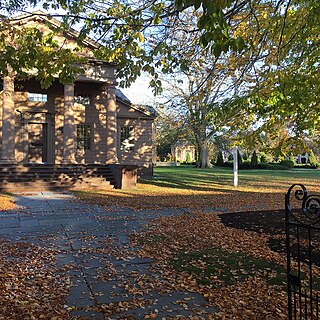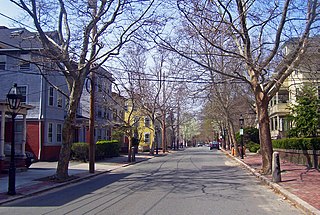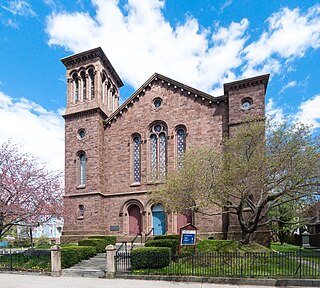Capt. John Mawdsley House | |
Mawdsley House in 2008 | |
| Location | Newport, Rhode Island |
|---|---|
| Coordinates | 41°29′3″N71°18′44″W / 41.48417°N 71.31222°W Coordinates: 41°29′3″N71°18′44″W / 41.48417°N 71.31222°W |
| Built | 1680 |
| Part of | Newport Historic District (#68000001) |
| NRHP reference # | 83000180 [1] |
| Significant dates | |
| Added to NRHP | July 2, 1983 |
| Designated NHLDCP | November 24, 1968 |
The Captain John Mawdsley House, located at 228 Spring Street, is one of the oldest houses in Newport, Rhode Island.

Newport is a seaside city on Aquidneck Island in Newport County, Rhode Island, located approximately 33 miles (53 km) southeast of Providence, Rhode Island, 20 miles (32 km) south of Fall River, Massachusetts, 73 miles (117 km) south of Boston, and 180 miles (290 km) northeast of New York City. It is known as a New England summer resort and is famous for its historic mansions and its rich sailing history. It was the location of the first U.S. Open tournaments in both tennis and golf, as well as every challenge to the America's Cup between 1930 and 1983. It is also the home of Salve Regina University and Naval Station Newport, which houses the United States Naval War College, the Naval Undersea Warfare Center, and an important Navy training center. It was a major 18th-century port city and also contains a high number of buildings from the Colonial era.
Contents
The earliest rear part of the house was built on Spring Street before 1680, probably by Jireh Bull. Bull married Godsgift Arnold, daughter of Gov. Benedict Arnold. Captain John Mawdsley, a privateer, lived in the house in the eighteenth century and constructed the large front addition to the house. The Mawdsley House is located on 228 Spring Street and was added to the National Register of Historic Places in 1983. The house was owned by Historic New England (SPNEA) until it was sold in the late twentieth century. [2]

Benedict Arnold was president and then governor of the Colony of Rhode Island and Providence Plantations, serving for a total of 11 years in these roles. He was born and raised in the town of Ilchester, Somerset, England, likely attending school in Limington nearby. In 1635 at the age of 19, he accompanied his parents, siblings, and other family members on a voyage from England to New England, where they first settled in Hingham in the Massachusetts Bay Colony. In less than a year, they moved to Providence Plantation at the head of the Narragansett Bay at the request of Roger Williams. In about 1638, they moved once again, about five miles south to the Pawtuxet River, settling on the north side at a place commonly called Pawtuxet. Here they had serious disputes with their neighbors, particularly Samuel Gorton, and as a result put themselves and their lands under the jurisdiction of Massachusetts, a situation which lasted for 16 years.

A privateer is a private person or ship that engages in maritime warfare under a commission of war. The commission, also known as a letter of marque, empowers the person to carry on all forms of hostility permissible at sea by the usages of war, including attacking foreign vessels during wartime and taking them as prizes. Historically, captured ships were subject to condemnation and sale under prize law, with the proceeds divided between the privateer sponsors, shipowners, captains and crew. A percentage share usually went to the issuer of the commission. Since robbery under arms was once common to seaborne trade, all merchant ships were already armed. During war, naval resources were auxiliary to operations on land so privateering was a way of subsidizing state power by mobilizing armed ships and sailors.

The National Register of Historic Places (NRHP) is the United States federal government's official list of districts, sites, buildings, structures, and objects deemed worthy of preservation for their historical significance. A property listed in the National Register, or located within a National Register Historic District, may qualify for tax incentives derived from the total value of expenses incurred preserving the property.

























